
Several plasma biomarkers and diagnostic panels of liver fibrosis have been tested ( 19, 20). Given the limitations of a liver biopsy for case finding, screening for clinically significant fibrosis has been centered on using serum biomarkers or liver imaging. Establishing the magnitude of the epidemic would be the first step to develop a sound public health policy. is rather modest, as the true prevalence of NAFLD, and specifically of NASH with fibrosis, remains unclear. However, evidence to support such a recommendation in the U.S. It has also been associated with an increased risk of cardiovascular disease, which is already increased in diabetes ( 11, 12). In addition, steatohepatitis is believed to be more progressive in patients with versus without T2DM ( 2, 9, 10). The rationale for screening such patients is based on increasing evidence that NASH with advanced fibrosis is associated with liver-related and extrahepatic morbidity and mortality ( 7, 8). In 2019, the American Diabetes Association (ADA) recommended that patients with type 2 diabetes mellitus (T2DM) with elevated plasma ALT levels or steatosis on liver ultrasound should be evaluated for NASH and liver fibrosis ( 6). The more severe form, known as nonalcoholic steatohepatitis (NASH), is characterized by predominantly lobular necroinflammation, with or without centrilobular fibrosis, which may progress to cirrhosis and even hepatocellular carcinoma ( 4, 5). Nonalcoholic fatty liver disease (NAFLD) is the most common chronic liver disease ( 1– 3).



 0 kommentar(er)
0 kommentar(er)
